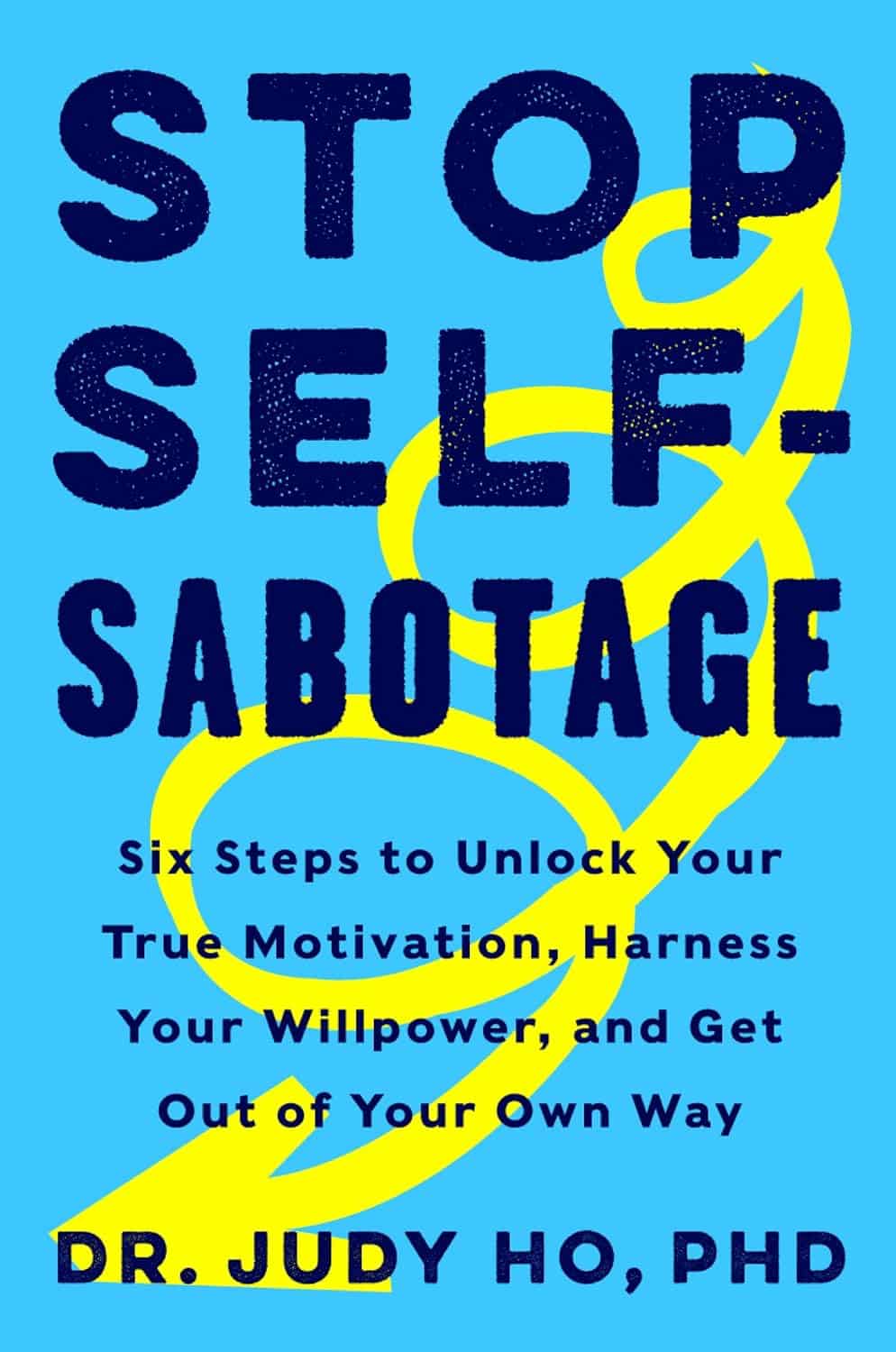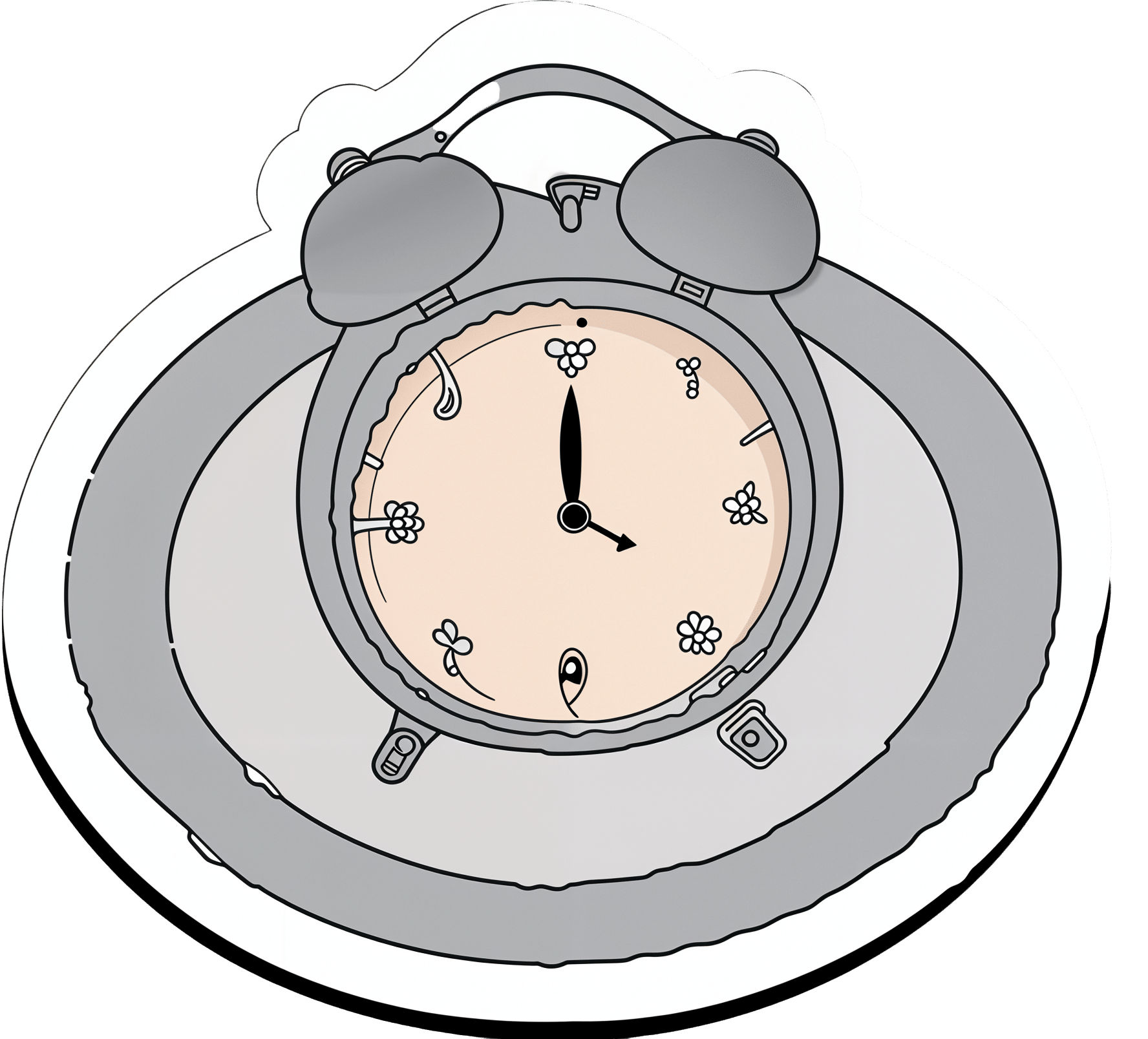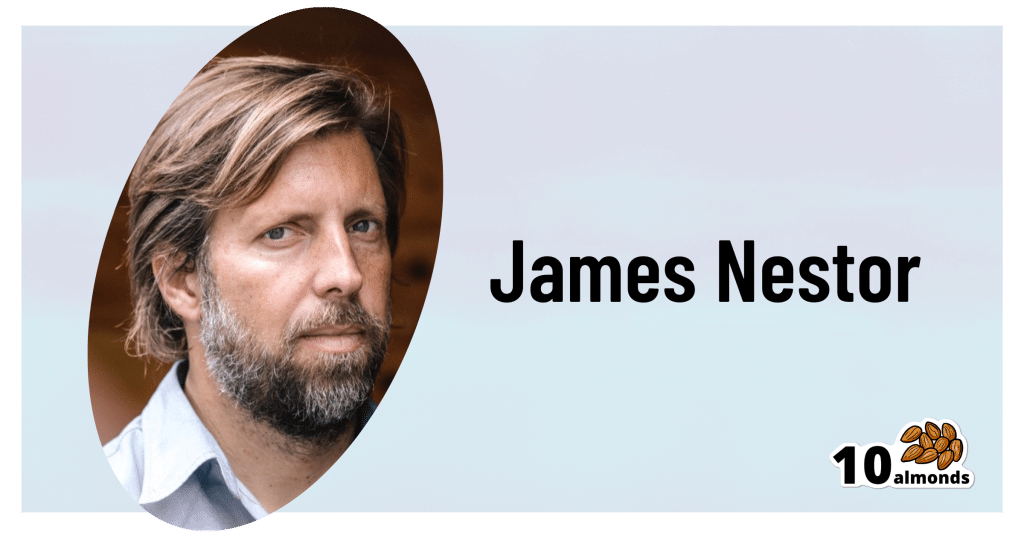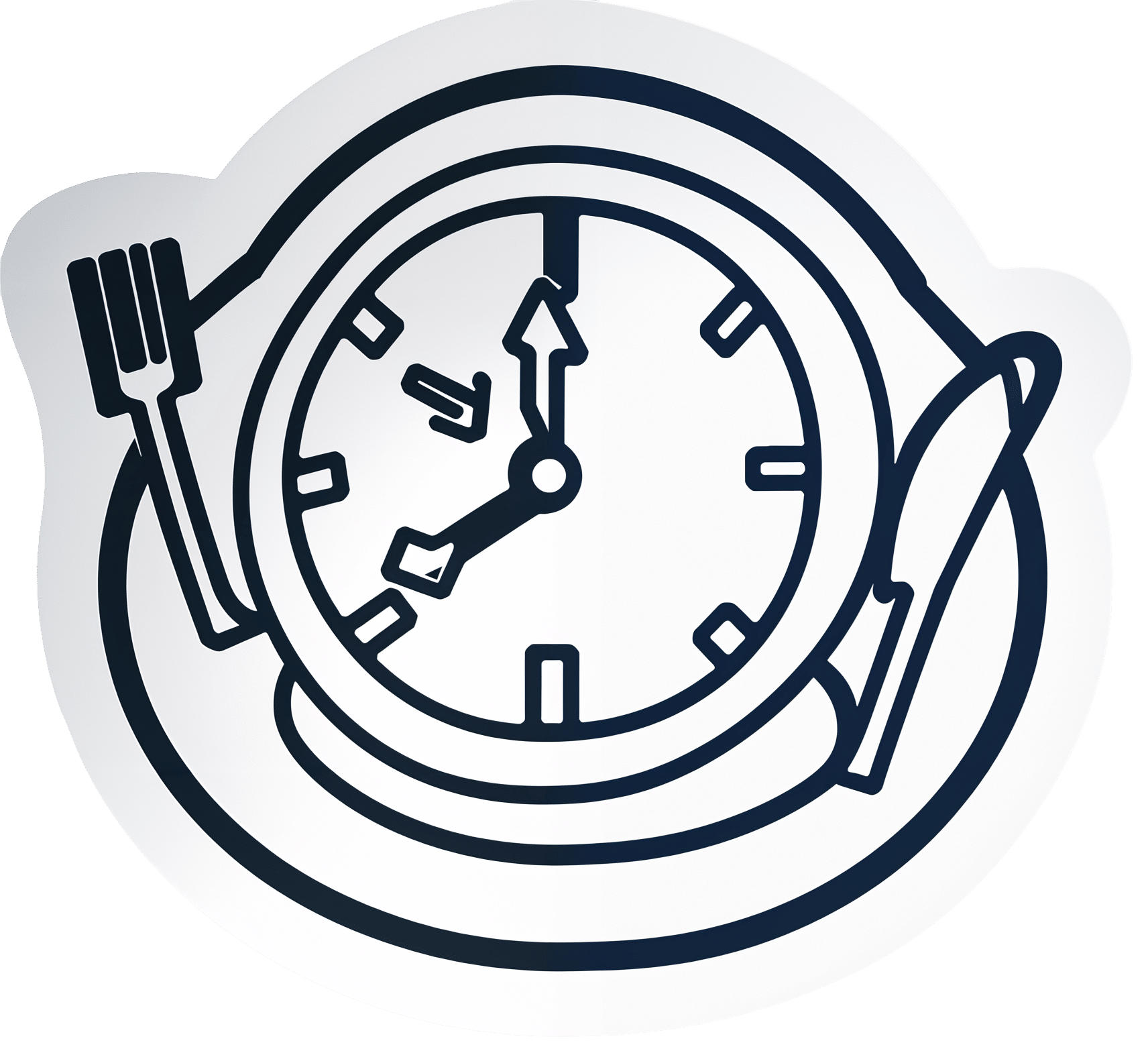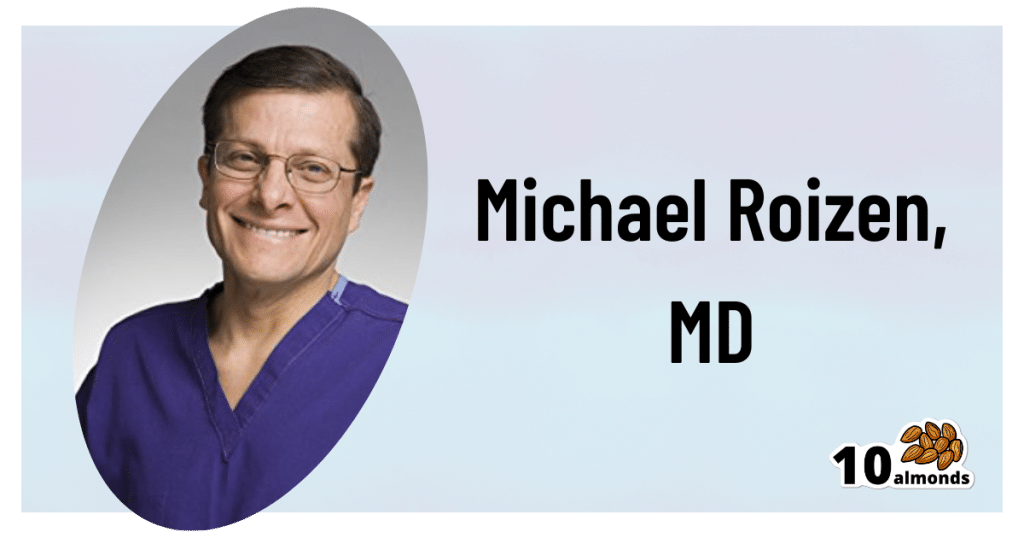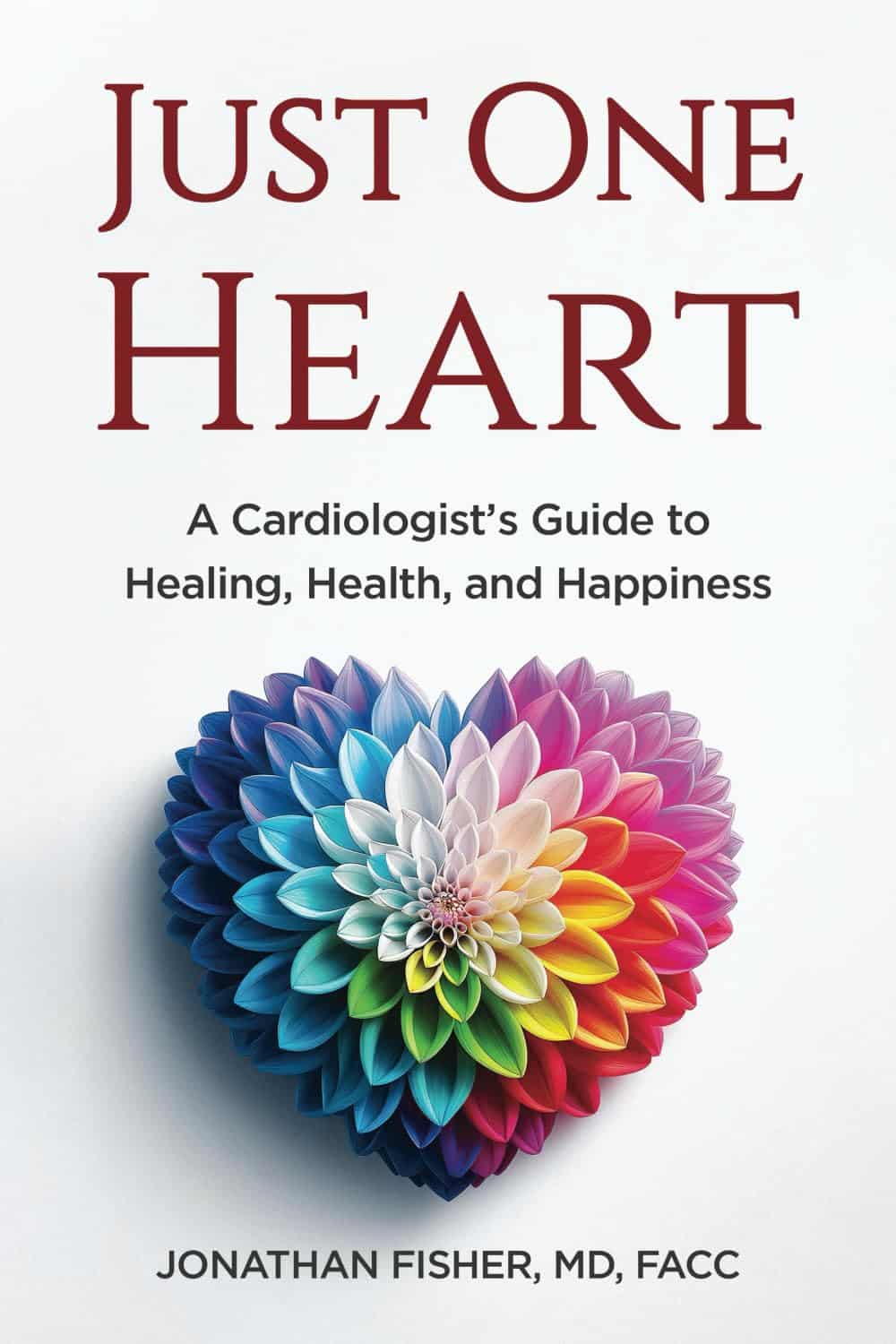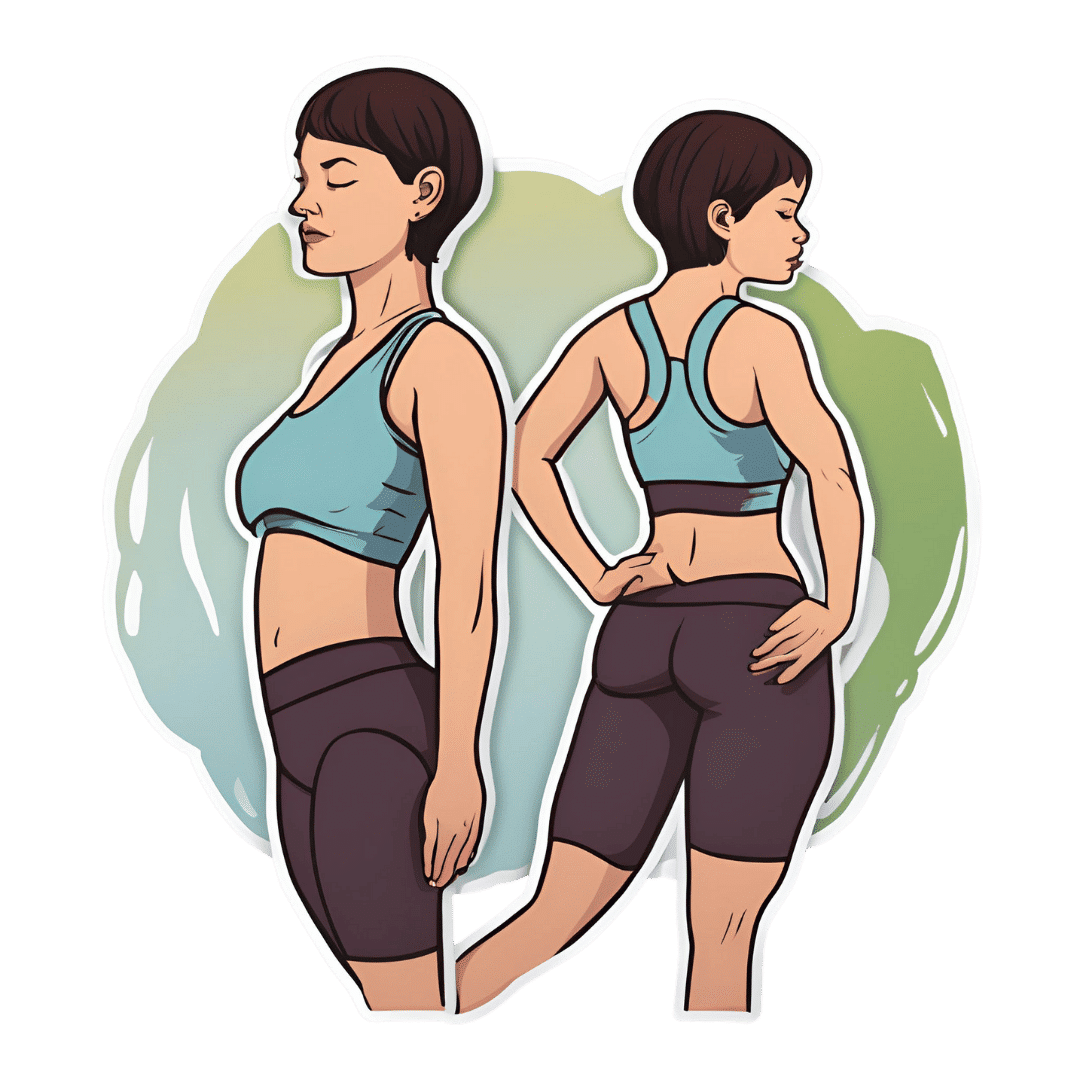
5 Minute Posture Improvement Routine!
10almonds is reader-supported. We may, at no cost to you, receive a portion of sales if you purchase a product through a link in this article.
McKay Lang walks us through it:
Step by Step
Breathing exercise:
- Place your hands on your lower abdomen.
- Take three deep breaths, focusing on body tension in the shoulders and neck… And release.
Shoulder squeeze:
- With your hands on your hips, inhale and squeeze your shoulders upwards.
- Hold your breath for 3–4 seconds, then exhale.
- Repeat two more times, holding the squeeze a little longer each time.
Upper shoulder massage:
- Massage your upper shoulder muscles to release tension stored there.
Overhead arm stretch:
- Raise your arms above your head, clasping each elbow with the opposite hand.
- Inhale deeply, stretch upwards, then exhale and release.
- Repeat, alternating elbows.
Neck and head push:
- Place your palms on the back of the head, and push your head into your hands (and vice versa, because of Newton’s Third Law of Motion).
- Do the same sideways (one side and then the other), to engage the other neck muscles.
Cool down:
- Gently unclasp your hands, bring your head upright, and massage your muscles. And breathe.
For variations and a visual demonstration of all, enjoy:
Click Here If The Embedded Video Doesn’t Load Automatically!
Want to learn more?
You might also like to read:
6 Ways To Look After Your Back
Take care!
Don’t Forget…
Did you arrive here from our newsletter? Don’t forget to return to the email to continue learning!
Recommended
Learn to Age Gracefully
Join the 98k+ American women taking control of their health & aging with our 100% free (and fun!) daily emails:
-
Stop Self-Sabotage – by Dr. Judy Ho
10almonds is reader-supported. We may, at no cost to you, receive a portion of sales if you purchase a product through a link in this article.
A lot of books of this genre identify one particular kind of self-sabotage, for example, they might pick one out of:
- Bad habits
- Limiting self-beliefs
- Poor goal-setting
- Procrastination
…etc, slap a quick fix on whatever they chose to focus on, and call it a day. Not so with Dr. Ho!
Here we have a much more comprehensive approach to tackling the problem of unintentional self-sabotage. With a multi-vector method, of which all angles can be improved simultaneously, it becomes much less like “whack-a-mole”… And much more like everything actually getting into order and staying that way.
The main approach here is CBT, but far beyond what most pop-psychology CBT books go for, with more techniques and resources.
On which note…
There are many great exercises that Dr. Ho recommends we do while reading… So you might want to get a nice notebook alongside this book if you don’t already have one! And what is more inspiring of optimism than a new notebook?
Bottom line: this is a great, well-organized guide to pruning the “why am I still doing this to myself?” aspects out of your life for a much more intentional, purposeful, effective way of living.
Click here to check it out on Amazon today, and stop sabotaging yourself!
Share This Post
-
Fasting Without Crashing?
10almonds is reader-supported. We may, at no cost to you, receive a portion of sales if you purchase a product through a link in this article.
Intermittent Fasting: What’s the truth?
Before we get to facts and fictions, let’s quickly cover:
What is Intermittent Fasting?
Intermittent Fasting (IF) is an umbrella term for various kinds of time-restricted fasting, based on a schedule. Types include:
Time-restricted IF, for example:
- 16:8—Fast for 16 hours, eat during an 8-hour window
- 18:6–Fast for 18 hours, eat during a 6-hour window
- 20:4—Fast for 20 hours, eat during a 4-hour window
24hr fasting, including:
- Eat Stop Eat—basically, take a day off from eating once a week
- Alternate Day Fasting—a more extreme version of the above; it is what it sounds like; eat one day, fast the next, repeat
Non-fast fasting, e.g:
- 5:2—Eat normally for 5 days, have a very reduced calorie intake (⅓ of normal intake) for the other 2 days
- Fruit Fasting—have a small amount of fruit on “fast” days, but no other food
- The Warrior Diet—as above, but include a small amount of non-starchy vegetables
Why IF?
While IF is perhaps most commonly undertaken as a means of fat loss or fat management (i.e., keeping fat down when it is already low), others cite different reasons, such as short term cognitive performance or long-term longevity.
But… Does it work?
Here we get into the myth-busting bit!
“IF promotes weight loss”
Mix of True and False. It can! But it also doesn’t have to. If you’re a bodybuilder who downs 4,000 calories in your 4hr eating window, you’re probably not going to lose weight! For such people, this is of course “a feature, not a bug” of IF—especially as it has been found that, in an acute study, IF did not adversely impact muscle protein synthesis.
“IF promotes fat loss, without eating less”
Broadly True. IF was found to be potentially equal to, but not necessarily better than, eating less.
“IF provides metabolic benefits for general health”
Broadly True. IF (perhaps counterintuitively) decreases the risk of insulin resistance, and also has anti-inflammatory effects, benefits a healthy gut microbiome, and promotes healthy autophagy (which as we noted in a previous edition of 10almonds, is important against both aging and cancer)
However, results vary according to which protocol you’re observing…
For what it’s worth, 16:8 is perhaps the most-studied protocol. Because such studies tend to have the eating window from midday to 8pm, this means that—going against popular wisdom—part of the advice here is basically “skip breakfast”.
“Unlike caloric restriction, IF is sustainable and healthy as a long-term protocol”
Broadly True. Of course, there’s a slight loophole here in that IF is loosely defined—technically everyone fasts while they’re sleeping, at the very least!
However, for the most commonly-studied IF method (16:8), this is generally very sustainable and healthy and for most people.
On the other hand, a more extreme method such as Alternate Day Fasting, may be trickier to sustain (even if it remains healthy to do so), because it’s been found that hunger does not decrease on fasting days—ie, the body does not “get used to it”.
The American Journal of Clinical Nutrition wrote:
❝Alternate-day fasting was feasible in nonobese subjects, and fat oxidation increased. However, hunger on fasting days did not decrease, perhaps indicating the unlikelihood of continuing this diet for extended periods of time. Adding one small meal on a fasting day may make this approach to dietary restriction more acceptable.❞
“IF improves mood and cognition”
Mix of True and False (plus an honest “We Don’t Know” from researchers).
Many studies have found benefits to both mood and cognition, but in the short-term, fasting can make people “hangry” (or: “experience irritability due to low blood sugar levels”, as the scientists put it), and in the long term, it can worsen symptoms of depression for those who already experience such—although some studies have found it can help alleviate depressive symptoms.
Basically this is one where researchers typically append the words “more research is needed” to their summaries.
“Anyone can do IF”
Definitely False, unless going by the absolute broadest possible interpretation of what constitutes “Intermittent Fasting” to the point of disingenuity.
For example, if you are Type 1 Diabetic, and your blood sugars are hypo, and you wait until tomorrow to correct that, you will stand a good chance of going into a coma instead. So please don’t.
(On the other hand, IF may help achieve remission of type 2 diabetes)
Lastly, IF is broadly not recommend to children and adolescents, anyone pregnant or breastfeeding, and certain underlying health conditions not mentioned above (we’re not going to try to give an exhaustive list here, but basically, if you have a chronic health condition, we recommend you check with your doctor first).
WHICH APP?
Choosing a fasting app
Thinking of giving IF a try and would like a little extra help? We’ve got you covered!
Check out: Livewire’s 7 Best Intermittent Fasting Apps of 2023
Prefer to just trust us with a recommendation?
We like BodyFast—it’s #2 on Lifewire’s list, but it has an array of pre-set plans to choose from (unlike Lifewire’s #1, Zero), and plenty of clear tracking, scheduling help, and motivational features.
Both are available on both iOS and Android:
Share This Post
-
The Exercises That Can Fix Sinus Problems (And More)
10almonds is reader-supported. We may, at no cost to you, receive a portion of sales if you purchase a product through a link in this article.
Who nose what benefits you will gain today?
This is James Nestor, a science journalist and author. He’s written for many publications, including Scientific American, and written a number of books, most notably Breath: The New Science Of A Lost Art.
Today we’ll be looking at what he has to share about what has gone wrong with our breathing, what problems this causes, and how to fix it.
What has gone wrong?
When it comes to breathing, we humans are the pugs of the primate world. In a way, we have the opposite problem to the squashed-faced dogs, though. But, how and why?
When our ancestors learned first tenderize food, and later to cook it, this had two big effects:
- We could now get much more nutrition for much less hunting/gathering
- We now did not need to chew our food nearly so much
Getting much more nutrition for much less hunting/gathering is what allowed us to grow our brains so large—as a species, we have a singularly large brain-to-body size ratio.
Not needing to chew our food nearly so much, meanwhile, had even more effects… And these effects have become only more pronounced in recent decades with the rise of processed food making our food softer and softer.
It changed the shape of our jaw and cheekbones, just as the size of our brains taking up more space in our skull moved our breathing apparatus around. As a result, our nasal cavities are anatomically ridiculous, our sinuses are a crime against nature (not least of all because they drain backwards and get easily clogged), and our windpipes are very easily blocked and damaged due to the unique placement of our larynx; we’re the only species that has it there. It allowed us to develop speech, but at the cost of choking much more easily.
What problems does this cause?
Our (normal, to us) species-wide breathing problems have resulted in behavioral adaptations such as partial (or in some people’s cases, total or near-total) mouth-breathing. This in turn exacerbates the problems with our jaws and cheekbones, which in turn exacerbates the problems with our sinuses and nasal cavities in general.
Results include such very human-centric conditions as sleep apnea, as well as a tendency towards asthma, allergies, and autoimmune diseases. Improper breathing also brings about a rather sluggish metabolism for how many calories we consume.
How are we supposed to fix all that?!
First, close your mouth if you haven’t already, and breathe through your nose.
In and out.
Both are important, and unless you are engaging in peak exercise, both should be through your nose. If you’re not used to this, it may feel odd at first, but practice, and build up your breathing ability.
Six seconds in and six seconds out is a very good pace.
If you’re sitting doing a breathing exercise, also good is four seconds in, four seconds hold, four seconds out, four seconds hold, repeat.
But those frequent holds aren’t practical in general life, so: six seconds in, six seconds out.
Through your nose only.
This has benefits immediately, but there are other more long-term benefits from doing not just that, but also what has been called (by Nestor, amongst many others), “Mewing”, per the orthodontist, Dr. John Mew, who pioneered it.
How (and why) to “mew”:
Place your tongue against the roof of your mouth. It should be flat against the palate; you’re not touching it with the tip here; you’re creating a flat seal.
Note: if you were mouth-breathing, you will now be unable to breathe. So, important to make sure you can breathe adequately through your nose first.
This does two things:
- It obliges nose-breathing rather than mouth-breathing
- It creates a change in how the muscles of your face interact with the bones of your face
In a battle between muscle and bone, muscle will always win.
Aim to keep your tongue there as much as possible; make it your new best habit. If you’re not eating, talking, or otherwise using your tongue to do something, it should be flat against the roof of your mouth.
You don’t have to exert pressure; this isn’t an exercise regime. Think of it more as a postural exercise, just, inside your mouth.
Quick note: read the above line again, because it’s important. Doing it too hard could cause the opposite problems, and you don’t want that. You cannot rush this by doing it harder; it takes time and gentleness.
Why would we want to do that?
The result, over time, will tend to be much healthier breathing, better sinus health, freer airways, reduced or eliminated sleep apnea, and, as a bonus, what is generally considered a more attractive face in terms of bone structure. We’re talking more defined cheekbones, straighter teeth, and a better mouth position.
Want to learn more?
This is the “Mewing” technique that Nestor encourages us to try:
Share This Post
Related Posts
-
Strategic Wellness
10almonds is reader-supported. We may, at no cost to you, receive a portion of sales if you purchase a product through a link in this article.
Strategic Wellness: planning ahead for a better life!
This is Dr. Michael Roizen. With hundreds of peer-reviewed publications and 14 US patents, his work has been focused on the importance of lifestyle factors in healthy living. He’s the Chief Wellness Officer at the world-famous Cleveland Clinic, and is known for his “RealAge” test and related personalized healthcare services.
If you’re curious about that, you can take the RealAge test here.
(they will require you inputting your email address if you do, though)
What’s his thing?
Dr. Roizen is all about optimizing health through lifestyle factors—most notably, diet and exercise. Of those, he is particularly keen on optimizing nutritional habits.
Is this just the Mediterranean Diet again?
Nope! Although: he does also advocate for that. But there’s more, he makes the case for what he calls “circadian eating”, optimally timing what we eat and when.
Is that just Intermittent Fasting again?
Nope! Although: he does also advocate for that. But there’s more:
Dr. Roizen takes a more scientific approach. Which isn’t to say that intermittent fasting is unscientific—on the contrary, there’s mountains of evidence for it being a healthful practice for most people. But while people tend to organize their intermittent fasting purely according to convenience, he notes some additional factors to take into account, including:
- We are evolved to eat when the sun is up
- We are evolved to be active before eating (think: hunting and gathering)
- Our insulin resistance increases as the day goes on
Now, if you’ve a quick mind about you, you’ll have noticed that this means:
- We should keep our eating to a particular time window (classic intermittent fasting), and/but that time window should be while the sun is up
- We should not roll out of bed and immediately breakfast; we need to be active for a bit first (moderate exercise is fine—this writer does her daily grocery-shopping trip on foot before breakfast, for instance… getting out there and hunting and gathering those groceries!)
- We should not, however, eat too much later in the day (so, dinner should be the smallest meal of the day)
The latter item is the one that’s perhaps biggest change for most people. His tips for making this as easy as possible include:
- Over-cater for dinner, but eat only one portion of it, and save the rest for an early-afternoon lunch
- First, however, enjoy a nutrient-dense protein-centric breakfast with at least some fibrous vegetation, for example:
- Salmon and asparagus
- Scrambled tofu and kale
- Yogurt and blueberries
Enjoy!
Don’t Forget…
Did you arrive here from our newsletter? Don’t forget to return to the email to continue learning!
Learn to Age Gracefully
Join the 98k+ American women taking control of their health & aging with our 100% free (and fun!) daily emails:
-
What’s the difference between ADD and ADHD?
10almonds is reader-supported. We may, at no cost to you, receive a portion of sales if you purchase a product through a link in this article.
Around one in 20 people has attention-deficit hyperactivity disorder (ADHD). It’s one of the most common neurodevelopmental disorders in childhood and often continues into adulthood.
ADHD is diagnosed when people experience problems with inattention and/or hyperactivity and impulsivity that negatively impacts them at school or work, in social settings and at home.
Some people call the condition attention-deficit disorder, or ADD. So what’s the difference?
In short, what was previously called ADD is now known as ADHD. So how did we get here?
Let’s start with some history
The first clinical description of children with inattention, hyperactivity and impulsivity was in 1902. British paediatrician Professor George Still presented a series of lectures about his observations of 43 children who were defiant, aggressive, undisciplined and extremely emotional or passionate.
Since then, our understanding of the condition evolved and made its way into the Diagnostic and Statistical Manual of Mental Disorders, known as the DSM. Clinicians use the DSM to diagnose mental health and neurodevelopmental conditions.
The first DSM, published in 1952, did not include a specific related child or adolescent category. But the second edition, published in 1968, included a section on behaviour disorders in young people. It referred to ADHD-type characteristics as “hyperkinetic reaction of childhood or adolescence”. This described the excessive, involuntary movement of children with the disorder.
It took a while for ADHD-type behaviour to make in into the diagnostic manual. Elzbieta Sekowska/Shutterstock In the early 1980s, the third DSM added a condition it called “attention deficit disorder”, listing two types: attention deficit disorder with hyperactivity (ADDH) and attention deficit disorder as the subtype without the hyperactivity.
However, seven years later, a revised DSM (DSM-III-R) replaced ADD (and its two sub-types) with ADHD and three sub-types we have today:
- predominantly inattentive
- predominantly hyperactive-impulsive
- combined.
Why change ADD to ADHD?
ADHD replaced ADD in the DSM-III-R in 1987 for a number of reasons.
First was the controversy and debate over the presence or absence of hyperactivity: the “H” in ADHD. When ADD was initially named, little research had been done to determine the similarities and differences between the two sub-types.
The next issue was around the term “attention-deficit” and whether these deficits were similar or different across both sub-types. Questions also arose about the extent of these differences: if these sub-types were so different, were they actually different conditions?
Meanwhile, a new focus on inattention (an “attention deficit”) recognised that children with inattentive behaviours may not necessarily be disruptive and challenging but are more likely to be forgetful and daydreamers.
People with inattentive behaviours may be more forgetful or daydreamers. fizkes/Shutterstock Why do some people use the term ADD?
There was a surge of diagnoses in the 1980s. So it’s understandable that some people still hold onto the term ADD.
Some may identify as having ADD because out of habit, because this is what they were originally diagnosed with or because they don’t have hyperactivity/impulsivity traits.
Others who don’t have ADHD may use the term they came across in the 80s or 90s, not knowing the terminology has changed.
How is ADHD currently diagnosed?
The three sub-types of ADHD, outlined in the DSM-5 are:
- predominantly inattentive. People with the inattentive sub-type have difficulty sustaining concentration, are easily distracted and forgetful, lose things frequently, and are unable to follow detailed instructions
- predominantly hyperactive-impulsive. Those with this sub-type find it hard to be still, need to move constantly in structured situations, frequently interrupt others, talk non-stop and struggle with self control
- combined. Those with the combined sub-type experience the characteristics of those who are inattentive and hyperactive-impulsive.
ADHD diagnoses continue to rise among children and adults. And while ADHD was commonly diagnosed in boys, more recently we have seen growing numbers of girls and women seeking diagnoses.
However, some international experts contest the expanded definition of ADHD, driven by clinical practice in the United States. They argue the challenges of unwanted behaviours and educational outcomes for young people with the condition are uniquely shaped by each country’s cultural, political and local factors.
Regardless of the name change to reflect what we know about the condition, ADHD continues to impact educational, social and life situations of many children, adolescents and adults.
Kathy Gibbs, Program Director for the Bachelor of Education, Griffith University
This article is republished from The Conversation under a Creative Commons license. Read the original article.
Don’t Forget…
Did you arrive here from our newsletter? Don’t forget to return to the email to continue learning!
Learn to Age Gracefully
Join the 98k+ American women taking control of their health & aging with our 100% free (and fun!) daily emails:
-
Just One Heart – by Dr. Jonathan Fisher
10almonds is reader-supported. We may, at no cost to you, receive a portion of sales if you purchase a product through a link in this article.
First, what this is not: a book to say eat fiber, go easy on the salt, get some exercise, and so forth.
What this rather is: a book about the connection between the heart and mind; often written poetically, the simple biological reality is that our emotional state does have a genuine impact on our heart health, and as such, any effort to look after our heart (healthwise) would be incomplete without an effort to look after our heart (emotionally).
Dr. Fisher talks about the impact of stress and uncertainty, as well as peace and security, on heart health—and then, having sorted emotional states into “heart breakers” and “heart wakers”, he goes about laying out a plan for what is, emotionally and thus also physiologically, good for our heart.
Chapter by chapter, he walks us through the 7 principles to live by:
- Steadiness: how to steady your heart amid chaos
- Wisdom: how to develop a wise heart in uncertain times
- Openness: how to safely open your heart in a threatening world
- Wholeness: how to show up with your whole heart without going to pieces
- Courage: how to lead with a courageous heart when fear surrounds you
- Lightness: how to live with a light heart in a heavy world
- Warmth: how to love with a warm heart when life feels cold
The style is anything but clinical; it’s well-written, certainly, and definitely informed in part by his medical understanding of the heart, but it’s entirely the raw human element that shines throughout, and that makes the ideas a lot more tangible.
Bottom line: if you’d like your heart to be healthy (cardiac health) and your heart to be healthy (emotional health), this book is a very worthwhile read.
Click here to check out Just One Heart, and take care of yours!
Don’t Forget…
Did you arrive here from our newsletter? Don’t forget to return to the email to continue learning!
Learn to Age Gracefully
Join the 98k+ American women taking control of their health & aging with our 100% free (and fun!) daily emails:


